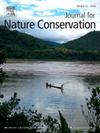Human wildlife conflict pattern analysis around Least explored Pakhro range of Jim Corbett National Park- A MaxEnt based case study
IF 2.2
3区 环境科学与生态学
Q2 BIODIVERSITY CONSERVATION
引用次数: 0
Abstract
Throughout history, human-wildlife conflicts have posed persistent challenges for wildlife conservation. With global population growth and extensive development, these conflicts have intensified, leading to casualties among both humans and wildlife. This pioneering study focuses on human-wildlife conflicts in villages near the less explored Pakhro range of Jim Corbett National Park, situated in the Himalayan foothills of India. Through extensive ground surveys, the study identifies conflict hotspots and assesses their severity, revealing the significant impact on local populations. It is revealed through this study a significant amount of population permanently migrated from the villages like Godi and Amsaur in past few years. Animal attacks and wildlife sightings are common occurrence in the region. In addition to this, the study also identifies conflict with herbivores like Elephants and Deers in the region which results in crop damage. To discover the factors driving these conflicts, a thorough MaxEnt-based analysis was conducted, integrating anthropogenic, topographic, and environmental variables based on literature and expert opinions with 86 location points where wildlife conflicts were reported. The model elucidates the impact of these factors on conflict occurrence in the region. It is clearly indicated from the results that parameters like LULC, proximity from waterbodies, slope, aspect, elevation play a key role in assessment of such conflict zones. The results highlight the significance of adopting a holistic approach, whereby considering multiple predictor variables enhances our ability to comprehensively understand and forecast human-animal conflict dynamics.
求助全文
约1分钟内获得全文
求助全文
来源期刊

Journal for Nature Conservation
环境科学-生态学
CiteScore
3.70
自引率
5.00%
发文量
151
审稿时长
7.9 weeks
期刊介绍:
The Journal for Nature Conservation addresses concepts, methods and techniques for nature conservation. This international and interdisciplinary journal encourages collaboration between scientists and practitioners, including the integration of biodiversity issues with social and economic concepts. Therefore, conceptual, technical and methodological papers, as well as reviews, research papers, and short communications are welcomed from a wide range of disciplines, including theoretical ecology, landscape ecology, restoration ecology, ecological modelling, and others, provided that there is a clear connection and immediate relevance to nature conservation.
Manuscripts without any immediate conservation context, such as inventories, distribution modelling, genetic studies, animal behaviour, plant physiology, will not be considered for this journal; though such data may be useful for conservationists and managers in the future, this is outside of the current scope of the journal.
 求助内容:
求助内容: 应助结果提醒方式:
应助结果提醒方式:


